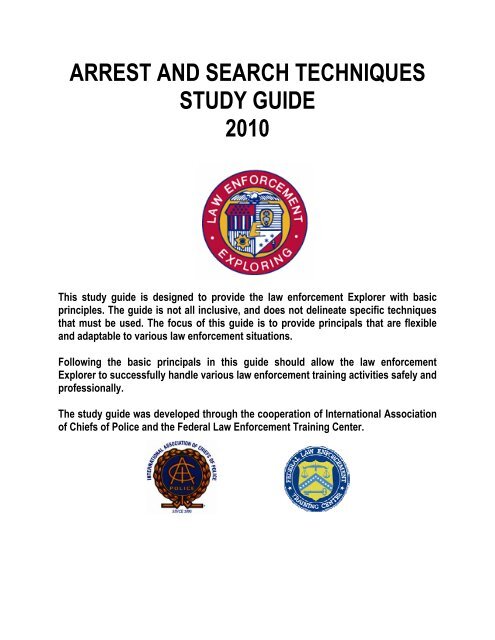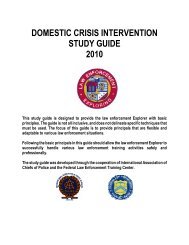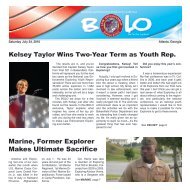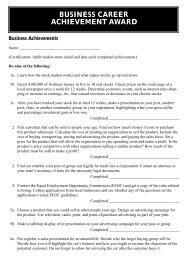ARREST AND SEARCH TECHNIQUES STUDY ... - Learning for Life
ARREST AND SEARCH TECHNIQUES STUDY ... - Learning for Life
ARREST AND SEARCH TECHNIQUES STUDY ... - Learning for Life
You also want an ePaper? Increase the reach of your titles
YUMPU automatically turns print PDFs into web optimized ePapers that Google loves.
<strong>ARREST</strong> <strong>AND</strong> <strong>SEARCH</strong> <strong>TECHNIQUES</strong><strong>STUDY</strong> GUIDE2010This study guide is designed to provide the law en<strong>for</strong>cement Explorer with basicprinciples. The guide is not all inclusive, and does not delineate specific techniquesthat must be used. The focus of this guide is to provide principals that are flexibleand adaptable to various law en<strong>for</strong>cement situations.Following the basic principals in this guide should allow the law en<strong>for</strong>cementExplorer to successfully handle various law en<strong>for</strong>cement training activities safely andprofessionally.The study guide was developed through the cooperation of International Associationof Chiefs of Police and the Federal Law En<strong>for</strong>cement Training Center.
<strong>ARREST</strong> <strong>AND</strong> <strong>SEARCH</strong> <strong>TECHNIQUES</strong><strong>STUDY</strong> GUIDETable of ContentsIntroduction………………………………………3Reponses based upon threat assessment………..4Handcuffing………………………………………9Searching suspects……………………………….10
INTRODUCTIONThis study guide is designed to provide the law en<strong>for</strong>cement explorer with the basic principalsconcerning arrest and search procedures. This guide is not all inclusive, and does not delineatespecific techniques that must be used. The focus of this guide is to provide principals that areflexible and adaptable to various law en<strong>for</strong>cement situations.Following the basic principals in this guide, should allow the law en<strong>for</strong>cement explorer tosuccessfully handle various law en<strong>for</strong>cement situations safely and professionally. The principalsin this guide are utilized by the Federal Law En<strong>for</strong>cement Training Center to train federalofficers and agents from more than 72 federal agencies.THREAT ASSESSMENTThere is an inherent danger associated with the law en<strong>for</strong>cement profession. Whether an officeris in a metropolitan area or a rural community, wearing a badge and a gun will put him indangerous situations.Threat assessment is the act of becoming aware of a situation directly through the senses,including hearing and seeing, thereby making a reasonable determination about the risksinvolved. Any suspect potentially can be assaultive and use deadly <strong>for</strong>ce. However,approaching every suspect in a high-risk mode (e.g., guns drawn) would be unreasonable. Therecan be many articulable facts that support threat assessment. Some of the facts used in thisjudgment decision are listed below; it is not a comprehensive list:• NCIC In<strong>for</strong>mation• BOLO In<strong>for</strong>mation• Physical actions• Suspect statements and/or spontaneous utterances• Suspicion level - Some or Mere/Reasonable/Probable Cause• Time of day• Number of officers/suspects• Size & ability of officers/suspects• Prior history/Criminal History• Officer’s experiences• Age - Officer vs. Suspect• Visible awareness - visible weapons/unusual bulges/unusual nervousness/hands in view• Frailness of suspect• Physical/mental disability of suspect• Magnetometer resultsSome of the facts above can be aggravating or mitigating. For example, if the suspect is elderlyhis age could be a mitigating factor reducing the perceived threat level. Remember, no matterwhat age a suspect is, guns are the great equalizers. Remember, no matter what age a suspect is,guns are the great equalizers. In 1997 at Calexico, Cali<strong>for</strong>nia, a seventy- four year-old man was
taken to be searched after a Customs Canine En<strong>for</strong>cement Officer's dog alerted on his vehicle <strong>for</strong>narcotics. In the search room the elderly man shot two officers. One of the injured officersreturned fire and stopped the attack. His shots killed the suspect.In addition to the prior list, there are also a number of articulable verbal and nonverbal signalsthat indicate an assault is probable or even imminent. Assessing behavior and preventing aphysical assault should be accomplished whenever possible. It is critical <strong>for</strong> an officer torecognize and assess aggressive verbal and physical actions of a person. Recognizing verbal andnonverbal aggressive behavior signals will aid the officer in preventing and de-escalatingsituations. Also, it prepares the officer mentally and physically to take immediate counter actionsshould a physical assault occur.Be<strong>for</strong>e physical action by an aggressor occurs, that individual usually begins to threaten toattack, in an attempt to intimidate the opponent, through a process sometimes called posturing,ritualized combat, or affective aggression. These “pre-assault indicators” are listed below. Thisis not an all-inclusive list:• Verbal aggression - yelling, swearing, etc.• A change in posture - stands taller, sets head and shoulders, moves away/moves closer,points, <strong>for</strong>ms fist and/or loads the arm.• Face becomes red, lips separate to show teeth, breathing becomes faster, and perspirationappears on the skin.• Individual ignores others, looks away or stares through people.• Creates a false sense of security by becoming very cooperative or acting incapacitated.• Aggression redirected to something/someone else, such as breaking pencils,kicking, chairs, yelling at bystanders• Individual's stance changes - blades body, lowers center of gravity, shifts weight.• Lips become tight as breathing, though still rapid, deepens. The face loses its flush tobecome pale.• Hands tighten, open or closed, arms and shoulders will shift.• Individual may bob or rock while shifting eyes to possible targets.• Individual may stop all motion in defiance.• Head will come down, chin tucked, eyebrows tightened and dropped.RESPONSES BASED UPON THREAT ASSESSMENTPosition of advantageOfficers should position themselves so they have a position of advantage over those persons theycontact. Threat assessment is the key to determining which position of advantage an officershould use. Positions of advantage can provide safety but must be balanced with efficiency. Forexample, when issuing the driver of a vehicle a speeding ticket the officer notices a weapon. It islikely that he will go from a position of low hands ready to a position of cover/distance and ahigh ready (pistol) position. Why not take the position of cover be<strong>for</strong>e seeing the weapon?Safety vs. efficiency, he cannot issue routine traffic tickets from behind cover. However, bybeing alert he can maximize his safety even during face-to-face encounters. Remember an4
officer’s position of advantage changes based on his threat assessment because differentsituations necessitate different positioning. No two situations are exactly alike.Field Interview StanceThe purpose of the field interview stance also known as the field interrogation stance or F.I.stance is to give the officer a proactive non-aggressive approach to self-defense. Officers shouldbe in a F.I. Stance whenever they are armed and near any member of the public. To assume thisstance, an officer must blade the trunk of his body with the gun (dominant) side turned awayfrom the person addressed. He positions his feet about shoulder width apart, with the kneesslightly bent to have good balance. The non-dominant leg is <strong>for</strong>ward and the dominant leg back.He distributes his body weight equally to allow <strong>for</strong> quick movement in any direction. He keepshis arms close to his sides, his dominant arm’s elbow close to his handgun and his hands near hiscenterline. The non-dominant hand is used <strong>for</strong> gesturing if necessary. This position keeps theofficer's firearm farther away from a potential threat.Low Ready PositionThe low hands ready position is almost the same as the F.I. Stance except the hands are held justup from the waist line in a palms down manner almost as if to gesture “calm down.” This handposition is a very good method to calm or keep a situation non-aggressive while ensuring theofficer is ready <strong>for</strong> self-defense against a spontaneous face-to-face attack. This position shouldbe used during any low threat face-to-face detention or arrest.High Ready PositionThe high ready position is slightly different than the low ready position. In the high readyposition, the officer’s hands are brought up to protect the head, while simultaneously wideningtheir feet and lowering their center of gravity. Widening the feet is known as “getting a base”.When getting a good base, the officers should have their feet more than shoulder width apart(wide), there feet should be offset, with the non-dominant foot <strong>for</strong>ward (deep), and they shouldlower their center of gravity keeping their head over their center. This allows the officer the bestposition <strong>for</strong> defending themselves and allows <strong>for</strong> tactical movement.When moving to the high ready position, the officer should provide loud verbal commands to thesuspect such as “get back, don’t resist”. This asserts that the officer is in control of the arrestsituation as well as identifying to the suspect and other possible witnesses what the officer wantsthe suspect to do.Contact and coverContact and cover is a principal that allows multiple officers to control subjects during a lawen<strong>for</strong>cement encounter. Designated roles of contact officer and cover officer are given so theresponsibilities of the officers at the scene of an en<strong>for</strong>cement situation are clearly defined.Having clearly defined responsibilities will provide greater safety <strong>for</strong> all officers. Whenreferring to safety most officers think about preventing an assailant, not a partner, from hurtingthem. Contact/cover procedures are safer than working alone only if each person understandshow to work with a partner. If the officers do not understand how to work as a team, there islittle benefit to having a partner. In fact, a partner can actually hurt other officers throughaccidental shootings or creating a false sense of safety.5
The contact officer is responsible <strong>for</strong> communication with the suspect and such things asrecording incident in<strong>for</strong>mation, searching suspects, issuing citations, and radio communications.The cover officers are there <strong>for</strong> scene safety, to witness/backup the contact officer, <strong>for</strong> control ofall suspects, and to ensure integrity in the chain of custody <strong>for</strong> evidence.When positioning themselves, the officers should approach the suspect in what is known as atactical “L” position. This is when the contact officer is position in front of the subject at a slightangle, and the cover officer positions themselves just outside the peripheral vision of the subject.The positioning allows both officers to observe the subject(s) without getting involved in acrossfire situation.Arriving on sceneWhen arriving on scene, or sometimes prior to arriving on scene, a law en<strong>for</strong>cement officer willstart the threat assessment process as was described earlier in the study guide. When the officerphysically arrives on scene, they can assess some of the physical characteristics that can be usedto their advantage such as cover and concealment.CoverThe term "cover" <strong>for</strong> law en<strong>for</strong>cement officers means an object or barrier that stops, deflects orsubstantially slows down bullets. Cover is better than concealment <strong>for</strong> officers in a high-risksituation because it provides better protection. Cover will change depending upon the type ofweapon and bullets used. Some commonly available types of cover include:• Ballistic shields• Car engine blocks• Car tires (brakes and brake drums)• Metal or concrete structural columns• Corners of buildings• Large trees• Mail boxes• Dumpster• File cabinets filled with paper files• Structural columnsConcealmentThe term "concealment" means something that can hide a person from view but that would notstop bullets. Although cover is preferable to concealment, concealment is better than plain viewwhen officers are in a high-risk situation. The following are some examples of concealment:• Darkness/shadows• Car doors• Residential trash cans• Shrubs and small trees• Most office walls, made of concrete blocks or sheet rock• Partitions6
BarriersA barrier is an object that will stop a suspect from having a clear path to the officer. Barriers canbe as simple as a table, a desk, a car or any other object that a suspect will have to go around orover be<strong>for</strong>e accomplishing a hand-to-hand attack. A barrier is very useful during routineadministrative functions and in lower threat en<strong>for</strong>cement situations. A barrier may notnecessarily stop bullets or provide concealment. There<strong>for</strong>e, good cover should be sought inthose situations. By using a barrier, the suspect may never attack an officer even though thesuspect has the ability and intent to do so. The presence of a barrier may prevent the suspectfrom having the opportunity to assault and may allow an officer to use non lethal control optionsRelative PositioningRelative positioning describes the placement of officers in comparison to the suspect. Onemethod used to describe the relative positioning uses the number zero as the position directly infront and three as the position directly behind the suspect. The number two represents theposition out from either shoulder. Another method uses compass degrees such as zero, 90, 180,and 270. Regardless of the numbering system used, the approach and subsequent contact of anysuspect should be initiated from specific angles or avenues to provide the officer with a physicaladvantage and a greater margin of safety. These angles are used in en<strong>for</strong>cement situations wherea distance interval has been established with the suspect such as during an interview or when anattempt is being made to control the suspect using an intermediate weapon. For an officer with afirearm aimed at a suspect, the changing of the officer’s relative positioning may allow <strong>for</strong> targetisolation, keeping innocent persons out of the sight picture.Communication SkillsAn officer’s communication can be broken down into three categories: officer presence,verbalization, and listening, all of which are part of a continuous communication process.Ninety seven percent of law en<strong>for</strong>cement work involves communicating with the public. Anofficer can inflame a situation through miscommunication or misinterpreting the communicationreceived. The officer can also de-escalate a potentially violent situation through appropriateapplication of good communication skills. It is always better to talk someone into voluntarycooperation than to fight them into compliance.7
Officer presenceThe mere presence of an officer on the scene can sometimes defuse a volatile situation andprevent an assault. Command presence, which includes the officer’s appearance, mannerisms,tone of voice, posture, gestures, facial expressions, and eye contact, should convey a sense ofauthority, tempered with compassion. Like actors, officers need to change their nonverbal andsymbolic communication <strong>for</strong> varying situations. In some situations, officers must be acompassionate and caring friend to a victim while other situations may require the stoicen<strong>for</strong>cement of an unpopular law. Remember it is human nature to make judgments about howsomeone looks and everything else being equal, a suspect is more likely to challenge an officerwho looks inattentive and weak.VerbalizingThe goals of verbal communication <strong>for</strong> the law en<strong>for</strong>cement officer are to direct, to control, andto gather in<strong>for</strong>mation. Officers should make every ef<strong>for</strong>t to de-escalate situations by voicecommands and by asking <strong>for</strong> cooperation. The words used and the tone of voice must conveythe message the officer wants to send. Eliminate barriers to communication. When givingdirections, keep it simple.Low Threat Assistance/Interview SituationsWhen dealing with compliant suspects and passive resistors, verbal commands and requests <strong>for</strong>assistance are often adequate to accomplish the desired behavior. Always calibrate the intensityof voice to the context of the situation. Ask them their name: personalize the interaction. Givethem options, and point out why they would want to cooperate. With victims, providepsychological first aid. Paraphrase their responses and meaning.High Threat/Assaultive SituationsBe firm, authoritative. Tell them specifically what they must do. Do not use threatening orfighting words or profanity. Continue to give commands while employing other use of <strong>for</strong>ceoptions. When working with a partner, do not give conflicting commands.Emotionally Disturbed Persons/Abnormal BehaviorAbnormal Behavior can be caused by a variety of conditions, including diminished mental oremotional capacity, drug and alcohol influences, and numerous medical conditions. Whilegenerally not dangerous, many people displaying abnormal behavior are highly unpredictable.They are easily frightened and often do not understand simple commands. Techniques <strong>for</strong>handling abnormal behavior include using extreme caution, assessing the cause of the behavior,calling <strong>for</strong> assistance, speaking slowly and softly, removing distractions, explaining actions inadvance, and using physical contact as a last resort.ListeningListening is a critical part of the officer’s job. Almost all aspects of law en<strong>for</strong>cement involveactive listening. Hearing is not the same as listening. Listen <strong>for</strong> the intended meaning of thewords used. Listen <strong>for</strong> feelings and emotions involved. Listen <strong>for</strong> the nonverbal sounds thatindicate understanding. Listen <strong>for</strong> verbal clues that could indicate an attack. Words and actionsshould match. Listen <strong>for</strong> communications/signals between suspects. Listen <strong>for</strong> tone of voice and8
volume. A change in tone or volume could indicate a change in intent. Listen <strong>for</strong> clues ofcompliance or surrender. Listen to other officers on the scene: send the same message.During high stress situations, people often experience auditory exclusion, where the ability tohear is diminished or distorted. For that reason, during most high threat situations (rapid raids,suspect with a weapon) officers should speak loud, clear, and concise using short repetitivecommands. Officers should identify themselves as the police to keep it simple and clear. Overaccentuate the word “POLICE” so that it will not be confused with the word “PLEASE”, whichmay happen when it is said rapidly under stress. In extreme situations such as an assault be sureto yell commands loud enough to warn innocent bystander and to get backup.H<strong>AND</strong>CUFFINGHandcuffingRegardless of the specific type of technique or style used to handcuff a suspect there are a fewprinciples that are common to any handcuffing:Position of Advantage/DisadvantageBe<strong>for</strong>e attempting to apply handcuffs on a suspect, the officer should be in a position ofadvantage. This usually means the officer is behind the suspect and the suspect is positionedstanding with his feet spread wide, toes out and hands behind his back. The kneeling position ofdisadvantage is with the suspect’s knees together, ankles crossed and sitting back on his ankleswith his arms behind the back. The prone position of disadvantage is with the suspect’s feetspread wide, toes out and arms out to the side with his palms up. When positioning the suspect<strong>for</strong> handcuffing, the officer should have cover officers and distance (minimum of >5 ft. <strong>for</strong> lowthreat) and, if necessary, using cover/concealment/barriers. During a face-to-face interaction thatspontaneously becomes a handcuffing situation, it is unlikely that distance or cover will be used.Instead, the officer would likely keep close contact to the suspect and direct him to the properhandcuffing position.Speed CountsOnce in the contact zone (0-5 feet) and the decision to handcuff has been made, get the handcuffson quickly. Do not get caught up about what direction the keyholes are facing. It is important tohave the suspect’s thumbs up and palms out but during a noncompliant arrest even thisconsideration is not weighted heavily.Handcuff Suspects behind Their BackFor different handcuffing styles, the suspect’s hands may start in a different position (i.e. on thehead), but once both handcuffs are on, the suspect’s hands must finish behind his back.Preferably with the palms out and thumbs up. If the suspect cannot bring his wrists close togetherbehind his back, then two sets of handcuffs secured together may work. Physical restrictions ofthe suspect, length of time in the handcuffs, court orders and other considerations may justifyhandcuffing the suspect with his hands in front even though it is less safe. If handcuffing infront, use a martin chain (belly chain).Proper PlacementApply the handcuffs around the notches at the wrist, the styloid process of the radius and ulna.Ensure they are properly tightened so that circulation is not cut off to the suspect’s fingers and so9
the suspect cannot slip out of the handcuffs. Never leave handcuffs applied over the suspect'sclothing i.e., jacket sleeves, because it gives a false sense of tightness and the suspect may easilyslip out of the cuffs.Double LockAlways double lock the handcuffs be<strong>for</strong>e transporting a suspect. This is usually doneimmediately after tightening although during multiple arrests and other extenuatingcircumstances it may be better to temporally delay double locking the handcuffs <strong>for</strong> tacticalpurposes.<strong>SEARCH</strong>ING SUSPECTSPrinciples of SearchingThe following are principles of doing a hands-on search of a suspect. Individual techniques willvary but these general principles should be followed.Position Of DisadvantageBased on the threat assessment the suspect must be in a position of disadvantage. This is done toallow <strong>for</strong> an easier search and to prevent the suspect from harming the officers. Positions ofdisadvantage may include standing, kneeling or prone positionsHolstered WeaponThe searching officer must not search with his firearm drawn although cover officers may have aweapon drawn under appropriate circumstances. If prior to the search the officer’s firearm wasout, such as during a weapon recovery, the firearm must be holstered securely prior to anysearching of the suspect.Ask About Sharp ObjectsAsk the suspect if he is carrying any needles or sharp objects be<strong>for</strong>e the search begins. Thisquestion is not a violation of Miranda regardless of whether the Miranda rights have been reador invoked. Visually inspect personal property be<strong>for</strong>e physically searching. Smaller bags andpurses may be carefully emptied and contents visually examined be<strong>for</strong>e being handled.Wear GlovesIf an officer who is not wearing gloves encounters soiled or possibly contaminated clothing, hemust wash or wipe his hands immediately and put on a pair of gloves be<strong>for</strong>e continuing thesearch. If it is necessary to handle soiled articles as the search continues, do so with extremecaution. If a hypodermic needle, knife or other sharp object is found, one option is to carefullyplace it in a puncture resistant container.One Searching OfficerOnly one officer should conduct the search of the suspect. This does not preclude a backupofficer from helping to restrain the suspect rather; if more than one person conducts the searchareas are often overlooked.Systematic and Thorough10
The search should be done in a systematic and thorough manner. There must be a logicalsequence to the search or the searcher will miss something. Head to toe and back to front is asimple systematic method. An officer looking where he is searching will also help.Feel, Crush, and TwistTo prevent accidental punctures the technique of feeling, crushing, and twisting the clothing isused. Conduct a lighter feel search of the areas where needles and sharp items may be locatedbe<strong>for</strong>e employing the crush/twist search. Never reach into a pocket without first feeling theoutside. There should not be hand to skin (underneath clothing) contact unless necessary torecover something during the search.Secure ItemsAll items taken from the suspect should be secured by the searching officer or a backup officerunless it is too dangerous to handle.11








